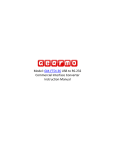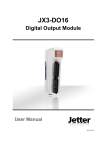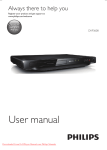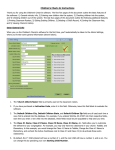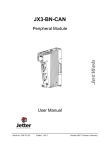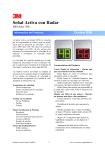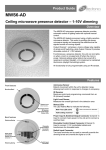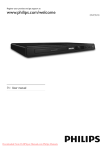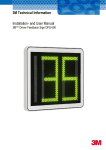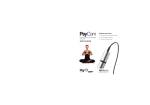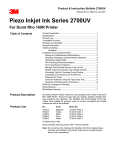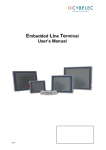Download Driver Feedback Sign
Transcript
Driver Feedback Sign DFS 700 Model Product Information October 2006 3M Driver Feedback Signs (DFS) are known as effective speed calming tools for traffic authorities. With the new DFS 700 model 3M offers state-of-the-art two-color LED display technology for informing drivers about their vehicle’s speed and reminding them of the given speed limit. Vehicle speeds that are measured by the integral microwave radar are displayed and logged for analyzing the speed reduction in order to confirm the effectivity of the DFS. Driver feedback signs are used on road sections where compliance with the posted speed limit is essential for traffic safety and quality of life. Example locations are: Speed Transitions Residential areas Areas with speed limits Work zones City entrances Accident Sites Dangerous curves Bridges Tunnels Vulnerable Road User Congregations Hospitals School zones Near old people’s homes Factory premises Bus stops University grounds Locations with Environmental Issues Noisy roads Polluted areas Product Features Various Operating Modes Buy much more than a speed feedback display Radar Mode for real-time speed information Limit Mode for displaying speed limit only Covert Mode for measuring speed without feedback (useful for effectiveness studies) Demo Mode for demo and inspection of display color, brightness, and flashing Two-color LED Display Display a clearer message to drivers Intuitive colors: green for info, red for warning Flashing display for additional warning 2 ½ digits for speeds up to 199 and readable from 100 m and more (for optimal conditions) 13-segment digits for better readability as compared to common 7-segment digits Brightness adaptation to ambient light for better readability Display Range Setting Define the speed range to react to Diagnostic Functions Easily verify proper operability of your DFS Limit highest shown speed to prevent misuse like intentional speeding Diagnostic check verifies data memory integrity, supply voltage, radar operation, GSM communication, Bluetooth comm. etc. Limit lowest shown speed to avoid detection of pedestrians or bicycles Self diagnostic check is executed at startup, at midnight or on user demand High Visibility Catch driver attention anytime Status codes indicate component status Increased sign visibility at night due to 3M Diamond Grade reflective sheeting Speed Data Analysis Download and analyze speed data with software Combineable with DG coated backboard for additional static messages Measure traffic volume and speed at a location Various Power Options Provide power to DFS anywhere Operate with line power using power supply unit, e.g. for fixed installations Operate with one or two optional 17Ah batteries for mobile applications Operate with battery buffered line power using optional charger in locations with temporary only line power (e.g. street lamp) Various Communication Options Communicate with DFS from any distance USB cable for local data link to PC Bluetooth for wireless link to PC or PDA Optional GSM for long distance wireless data connection from your office (requires data SIM card from local GSM provider) Various Installation Options Install DFS as you need Use DFS unit stand alone for fixed installations and connected to line power Use optional mounting box for mobile installations and to protect accessories Detach display from frame for integration in customized static sign board or cabinet SMS Notification (with optional GSM) Let the DFS tell you when it needs attention SMS on low (battery) voltage SMS when memory almost full or full and old data about to be overwritten SMS when diagnostic check identifies defect Create overview tables and several graphical charts with just a few mouse clicks Create before & after studies to determine speed reduction effectiveness of DFS Identify periodically speeding individuals Weekday Scheduling Define on/off time schedules per weekday Prevent habituation of drivers and increase credibility by activating the DFS only when needed, e.g. at school time in front of school Save power to increase battery time and increase LED life-time Userfriendly Design Save cost and time for installation and use Lightweight design (DFS only 8,5 kg) for transport and mounting by one person Software user interface design for highest user friendliness Optional battery & mounting box for a professional installation to different post diameters (60 – 140 mm) Safe and secure storage of accessories in optional battery & mounting box High Quality Standard Trust in highest reliability Closed design ensures protection against humidity and dust Self diagnostic functions allow quick verification of operability SMS notification function informs you about service needs (with GSM option) Included Components Optional Accessories The DFS 700 main unit is delivered as plug-andplay device including all needed components to directly operate and install it. Only the tools and qualified people for mounting, connecting and commissioning the device have to be provided. The package of the main unit contains the following parts: Different optional accessories can be purchased separately according to the specific needs of the customer and the application. 17 Ah lead-gel battery with cable and polarity protected connector. Up to two such batteries can be connected to a DFS 700 CD with PC and PDA software and DFS 700 installation and user manual. Also a USB cable and a Bluetooth stick for PC USB port Battery charger for charging the battery either directly or through the DFS Power supply unit for converting 230 Volt AC line power to 12 Volt DC for DFS 700 Lockable battery & mounting box for storing accessories and mounting the DFS to poles of 60 to 140 mm diameter Two brackets that can be attached to the frame ot the DFS for mounting it to a 60 mm pole GSM/GPRS modem for long distance comm. over 900 and 1800 MHz GSM networks Technical Data Dimensions & Weight 660 × 770 × 110 mm (w × h × d), 8,5 kg Radar Frequency 24,15 GHz – 24,25 GHz Operating Voltage 11,3 V – 15,0 V Radar Power 20 dBm, 100 mW e.i.r.p. Current (Power) Standby 0,02 A (0,24W) Radar mode w/o traffic (display inactive) 0,08 A (0,96 W) Radar mode with traffic (display active, one color @med brightness) 1,00 A (12 W) Peak current (less than 1 second with all components on) 5 A (60 W) Radar Speed Range and Accuracy Measures from 3 km/h to 199 km/h (can be limited) ± 2 km/h for speeds below 100 km/h ± 2 % for speeds above 100 km/h Power Supply Unit Input 100 V – 240 V AC @ 50 – 60 Hz Protection class 1 Output 12 V / 100 W IP 55, ca. 2 kg Battery Standby Time Approx. 850 hours using one completely charged 17 Ah battery Fuse ATO Fuse 4A T Cabinet Rating IP 54 Cabinet Color 7042 RAL Sign Face White Diamond Grade™ reflective sheeting Printable area 530 × 290 mm (w × h) Temperature Range –35 to + 75 °C (DFS 700 internal temp.) Humidity Range Up to 95 % Display 330 mm high, 450 mm wide 2 ½-digits (speed up to 199), 13 segments LEDs InGaAIP SMD LEDs, viewing angle 16 – 18° 3 rows green (570 nm), 3 rows red (635 nm) Backup Battery Lithium 3V CR2450, ca. 2 years lifetime Data Memory 1 MB non-volatile flash memory 100.000 data entries Radar Detection Range Approximately 100m for avg. 4-seat sedan Radar Beam Width 14° horizontal, 24° vertical Bluetooth Class 2 module, 4dBm transmission power, up to 20 m range Interfaces USB, Bluetooth, Charger input, Battery 1 input (charged when charger connected), Battery 2 input, Power switch, RS-232 (for GSM Modem), GSM power supply, Switchgear for ext. devices, Grounding bolt Switchgear 24 VAC / DC, 150 mA, connector type Weidmüller BLZF 3.5/3/F SNOR Firmware Flashable Software DFS-CAS for Windows 2000/XP PC DFS-CAS for Windows Mobile 5.0 PDA GSM Modem* Wavecom 900 MHz / 1800 MHz (requires SIM card with Circuit Switched Data Services from local GSM provider), ca. 0,25 kg Batteries* 12 V, 17 Ah, ca. 6kg Battery Charger* 100 V – 240 V AC @ 50 – 60 Hz Protection class 2 Max output 12 V / 60 W Temperatur range - 40° to +40° IP 67, ca. 1kg Battery & Mounting Box* For 60 to 140 mm pole diameters, ca. 7,5 kg *Optionally available accessories EU Standards Compliance Device Standard (Directive / Council Recommendation) DFS 700 EN 50293 (89/336/EEC EMC Directive) Electromagnetic compatibility - Road traffic signal systems - Product standard DFS 700 EN 300 440-2 (99/5/EC R&TTE Directive) Electromagnetic compatibility and Radio spectrum Matters (ERM); Short Range devices; Radio equipment to be used in the 1 GHz to 40 GHz frequency range; Part 2:Harmonized EN under article 3.2 of the R&TTE Directive DFS 700 EN 60950 / EN 60215 (73/23/EEC Low Voltage Directive) Safety of information technology equipment including electrical business equipment / Safety requirements for radio transmitting equipment EN 301 489-3 (99/5/EC R&TTE Directive) Electromagnetic compatibility and Radio DFS 700 Radar Unit spectrum Matters (ERM): ElectroMagnetic Compatibility (EMC) standard for radio equipment and services; Part 3: Specific conditions for Short-Range Devices (SRD) operating on frequencies between 9 kHz and 40 GHz EN 50392 (99/519/EC EMF Recommendation) Generic standard to demonstrate the compliance of electronic and electrical apparatus with the basic restrictions related to human exposure to electromagnetic fields (0 Hz - 300 GHz) DFS Bluetooth Module EN 301 489-17 (99/5/EC R&TTE Directive) Electromagnetic compatibility and Radio spectrum Matters (ERM): ElectroMagnetic Compatibility (EMC) standard for radio equipment and services; Part 17: Specific conditions for 2,4 GHz wideband transmission systems and 5 GHz high performance RLAN equipment EN 300 328 (99/5/EC R&TTE Directive) Electromagnetic compatibility and Radio spectrum Matters (ERM); Wideband Transmission systems; Data transmission equipment operating in the 2,4 GHz ISM band and using spread spectrum modulation techniques; Harmonized EN covering essential requirements under article 3.2 of R&TTE Directive EN 50392 (99/519/EC EMF Recommendation) Generic standard to demonstrate the compliance of electronic and electrical apparatus with the basic restrictions related to human exposure to electromagnetic fields (0 Hz - 300 GHz) DFS 700 GSM Modem* EN 301 489-7 (99/5/EC R&TTE Directive) Electromagnetic compatibility and Radio spectrum Matters (ERM): ElectroMagnetic Compatibility (EMC) standard for radio equipment and services; Part 7: Specific conditions for mobile and portable radio and ancillary equipment of digial cellular radio telecommunications systems (GSM and DCS) EN 301 511 (99/5/EC R&TTE Directive) Global System for Mobile communications (GSM); Harmonized standard for mobile stations in the GSM 900 and DCS 1800 bands covering essential requirements under article 3.2 of the R&TTE directive (1999/5/EC) EN 50392 (99/519/EC EMF Recommendation) Generic standard to demonstrate the compliance of electronic and electrical apparatus with the basic restrictions related to human exposure to electromagnetic fields (0 Hz - 300 GHz) 99/5/EC R&TTE Directive Directive of 9 March 1999 of the European Parliament and of the Council on Radio Equipment and Telecommunications Terminal Equipment and the mutual recognition of their conformity 89/336/EEC EMC Directive Council Directive of 3 May 1989 on the approximation of the laws of the Member States relating to electromagnetic compatibility 73/23/EEC Low Voltage Directive Council Directive of 19 February 1973 on the harmonisation of the laws of Member States relating to Electrical Equipment designed for use within certain voltage limits 99/519/EC EMF Recommendation Council Recommendation of 12 July 1999 on the limitation of exposure of the general public to electromagnetic fields (0 Hz to 300GHz) *Optionally available accessories 3M Deutschland GmbH Traffic Safety Systems Division Carl-Schurz-Straße 1 Postfach 10 04 22 41453 Neuss www.3M.com/de Copyright © 3M 2006







